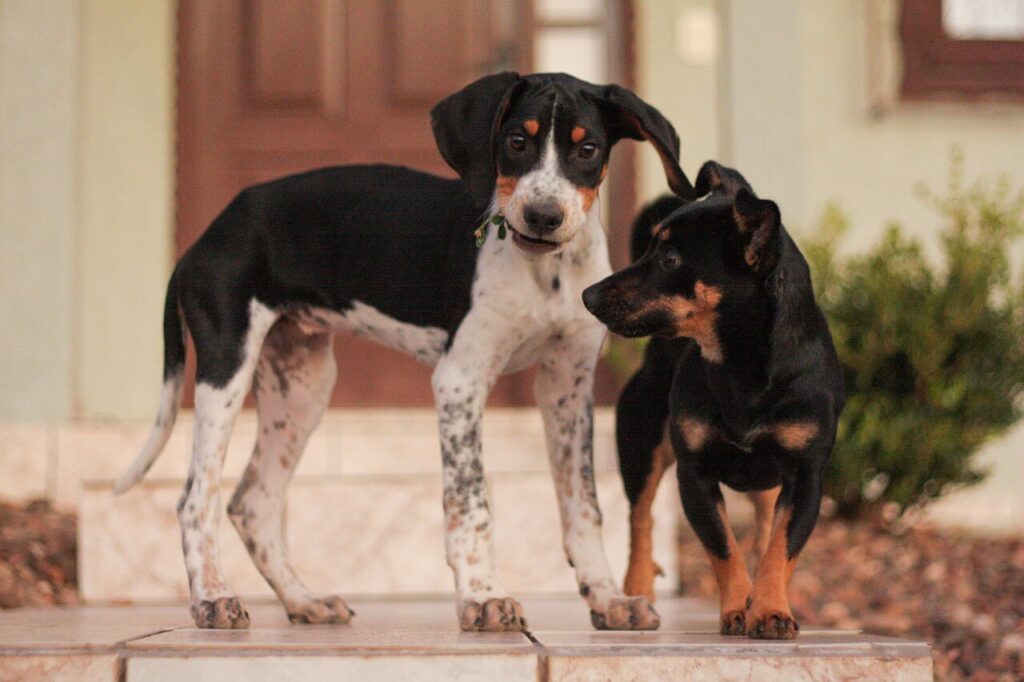Introducing a New Dog Into a Home with Dogs

Dogs are social creatures and are very pack oriented, so the majority of dogs can do well in a multi-dog home, if you choose to have more than one dog. The challenge is greater in breeds of dogs that are bred to be more solitary, or in dogs that have lost their canine communication skills. There are times when it is best to not introduce a new dog at all.
Will your dog be okay with a new dog in the home? How old is your dog? Is he in good health? Has he been properly exposed to dogs throughout his life? Has your dog been trained?
These questions are really important in considering whether to get another dog or not. Many people want to introduce a puppy in the twilight years of their senior dog’s life, but not every senior dog appreciates this. In some cases it brings a twinkle back to the old dog, but more commonly, the older dog is not up for puppy antics. Puppies are relentless in their attempts to play and for a tired or arthritic dog, this can be too much of a headache. Some older dogs are not puppy tolerant, and you may find that it is more than you bargained for. Your current dog may become aggressive towards the puppy.
If you have a dog that has always been an only dog and really hasn’t ever spent time with any other dogs, he may not know how to communicate with a new dog. He may view the new dog as a threatening intruder. He may guard his people, toys, and food against this threat. In some cases, depending on the dog’s personality, he may learn to adapt to a dog and other times he just doesn’t (or at least it’s far more difficult to attempt than warranted).
Do you have time for a new dog and has your first dog been trained properly? It’s a whole new ball game when you add a new dog, particularly if you’re going from a one dog home to a two dog home. Once you add a dog, it becomes a pack, and the dynamics change. Dogs might compete with each other for position within the home. Additionally, if you already have more than one dog, the dynamics between those current dogs will change with the addition of a new dog. There can be jealously and issues that arise.
These thoughts aren’t meant to scare you from adding a dog to your family, but are meant for consideration. It’s a big decision to add a new dog and can take time to do it properly. Ideally, you will match your dog’s personality with the new dog. For example, if your dog is bold and tends to get everything he wants with other dogs, you shouldn’t select the same personality or problems will ensue. You should try to match activity level as well. A very energetic dog is better paired with a similarly energetic dog instead of a couch potato.
Gender is also a big consideration. While it is possible to mix same sex dogs together, it is recommended to pick opposite sex pairings if you only have two dogs. These pairings generally do better together, and there are some dogs that don’t do well with their own gender at all but do just fine with an opposite pairing.
Once you’ve selected the right dog that blends in activity level and personality, you’ve got to mesh him into your home. If he has been adopted from a shelter or rescue group (or some other previous home situation), it is best if your current dog has met him before finalizing the paperwork. Once you get the new dog home, try taking the dogs for a walk and meeting on neutral ground. This can be less problematic than just coming in the house together.
Pick up all toys off the ground and don’t leave chew bones or dinner bowls on the floor either. These are all potential fight triggers, and until you are sure the dogs are well meshed and can handle having these triggers lying around, make sure to keep them away.
If you’re bringing home a puppy, it is still possible to meet on neutral ground, but this is often less practical. Instead, try placing your puppy inside a room with a baby gate across the door or inside a portable exercise pen. Then allow your current dog to greet him and sniff him through the fence. This keeps the puppy safe and allows your dog to get a look at the new guy.
The adjustment period takes up to 8 weeks to occur, so keep in mind that dogs change as they adjust to a new home. Try to give the dogs together time but also apart time to limit stress. Take them for walks together for positive time. Make sure to also do things with each dog alone so that they each have that individual time and not everything has to be shared, at least initially.
With puppies, make sure to keep the puppy busy and tired with play and exercise so that he is less bothersome to an adult dog. He can also retire for naps occasionally to give the adult dog a breather for a while too.
Begin training your new dog right away to avoid any bad habits from forming. This also helps make sure the new dog is on the same training level as the current dog as expectations should be the same for both dogs. No special treatment for either dog!
If your current dog is wary of the new dog or is showing aggression, the process can take a lot longer and will likely involve rotating dogs and behavior modification. Consulting with a professional would be highly recommended to make sure the process is done correctly, if possible.
